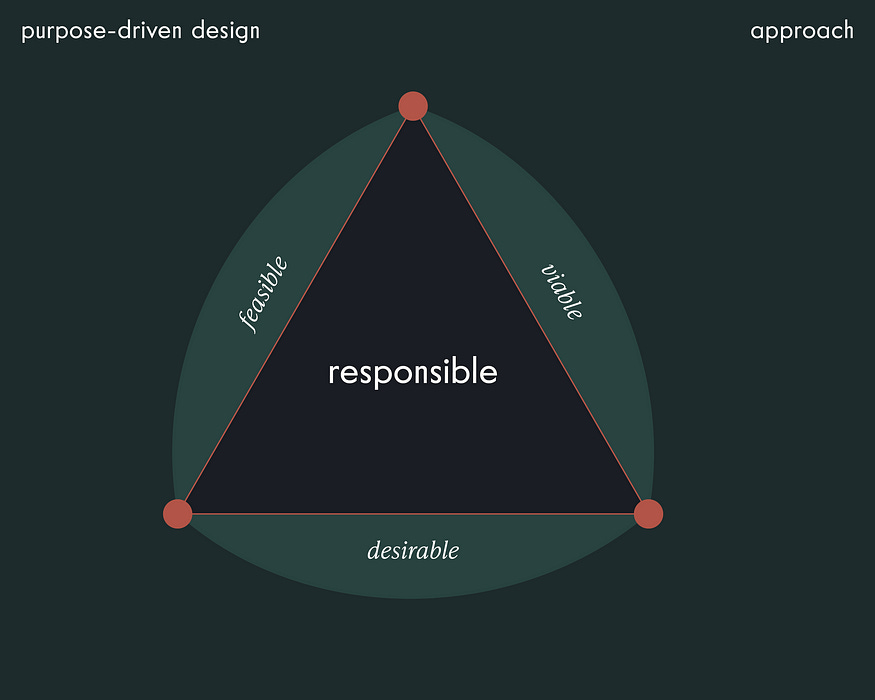Design with a Purpose: Why it matters now more than ever?
How design for social-impact meets proactive consumers’ demand for authenticity and social impact
Quick summary: Purpose-driven design is becoming essential for organisations and firms, as customers’ values have shifted and younger generations are less likely to support careless or dishonest businesses. Designers have already started creating impactful products and services that address societal and environmental concerns, going beyond just satisfying client needs. The real challenge for design studios is to remain ethical by balancing adaptation to change with maintaining their dedication to ‘design with a purpose’.
Have you ever felt that the work you enjoy and perform at still leaves you unfulfilled, making you question if you’re enough? The answer is that you weren’t lacking input; you didn’t make a bad choice (is what you enjoy doing, right?) but the project you were working for was lacking in purpose. In a corporate setting, purpose-driven design comes in to bring passion to the team, turns clients into loyal supporters, and boost financial state.
Table of Contents
Let’s start with the basics. What is purpose-driven design?
What does it mean to be a purpose-driven design studio?
New mission statement, purpose, vision and values for better alignment.
But do we have experience with these types of clients?
1. Let’s start with the basics. What is purpose-driven design?
First of all, what is Design? Design is the creative process of developing solutions to meet specific goals or solve problems, blending aesthetics with functionality. It touches various fields, like graphic and multimedia design and the main focus is usability, innovation, the overall user experience and of course beauty.
When design goes a step further and focuses on making a difference in the world, creating a positive impact on people’s lives and the planet, we may call it purpose-driven design.
Designers have always aimed to improve the conditions in which we live, interact, and experience by observing our daily and more complex problems. The main goal has always been to reduce stress and make things simpler and more practical for people. However, while meeting client needs, the final result can lack positive impact.
Contemporary designers should be aware of the changes happening in the world and start thinking beyond than satisfying immediate needs. They need to design for social impact, or risk remaining stuck in a cycle of creating short-term fixes and dopamine-driven solutions (like the introduction of single-use vapes in 2019). This often leads to the production of more and more plastic, the creation of unnecessary “needs,” increased waste, and contributions to social inequalities.
Final products and services should not focus solely on profit but also consider the impact on the environment and people. At the same time, designers must uphold ethical standards and be genuine with the consumers.
2. Why design studios that do not design with a purpose fall behind?
2.1. They have an outdated mentality
Design agencies and marketing teams often follow trends without considering the bigger picture, and social impact design is usually left out. From personal experience we have multiple examples of people in key positions saying things like, “Let’s use more AI to make it pop” “Make it fast because it is meant for mass production” “We are a startup and we really do not have money to be green “.
The problem is that their business plan and purpose is only focused on making big profits. This approach may have worked in the past, but today’s purpose-driven customers want meaningful engagement. They look for products or services that align with their values, and the organisation’s responsibility and ethics matter more than ever.

2.2 Their purpose is not aligned with the company’s culture
Apart from this, non-purpose companies don’t follow a shared culture, rooted in the company’s purpose. They struggle to inspire their employees with passion and dedication toward a bigger goal. A study conducted by ‘The Amazon Ads 2023 Higher Impact’ shows that 70% of global consumers prefer to buy products or services from companies with a good purpose. This is why companies that design with a purpose, not only achieve better financial performance but also drive the company’s growth and impact on the world.
For example, Patagonia has embedded sustainability in every aspect of its business mission. All its profits now go toward fighting climate crisis. Its commitment to remaining ethical and environmentally conscious has boosted customer and employee loyalty, elevating it to the top of B-Corp companies worldwide and proving the demand for companies that make an impact.
3. Are Gen Z and Millennials the real change-makers? Are they breaking the mold?
Why is this happening now? The world has changed significantly, and people are more engaged and community-aware. They’ve realised that the so-called American dream has largely failed. By not addressing climate change, reducing waste, or tackling inequality, they understand that sooner or later, they — or future generations — will face the consequences of our actions.
This sets Gen Z and Millennials apart from Gen X and Boomers. The younger generations tend to seek a sense of purpose before taking action. They understand that simply bragging about saving vacation days for the summer or completing 20 projects in a month isn’t enough.
On the contrary, they prioritise their mental health and well-being by working less and more efficiently on things they are passionate about. The same applies when they are in the position of buyers. Before making a purchase, they look for a strong reason behind it. A plastic cat toy may seem like just another piece of plastic, but a compostable one has a different value — it will not only keep your cat entertained but will also decompose when it’s no longer useful. What was once a common design becomes a design with a purpose and impact.
4. How do purpose-driven companies and organisations distinguish themselves from corporate businesses?
4.1. They have a main purpose that goes beyond making a profit.
Purpose-driven companies and organisations are motivated by a specific cause. They share a passion for a greater purpose that keeps them motivated to progress and find solutions. This dedication inspires both their employees and clients, driving them to contribute to the company’s mission.
4.2. Their products and services make an impact.
Throughout their processes, they ask themselves quite a lot whether their products or services creative a positive impact. Since everything has either a positive or negative effect, they frequently measure their influence by engaging in trial and error. This helps them identify the any pain points that may lead to irresponsible actions toward society or the greater good.
4.3. They collaborate and network with other companies and organisations with similar purpose.
For an organisation striving to design for social impact, it can be challenging in today’s fast-paced consumer landscape. This is why purpose-driven companies build partnerships, sometimes even with their “competitors”, to create a collective influence. They seek out collaborations and take bold actions that will bring them closer to their goals. Additionally, they organise workshops, events and activities, transforming their business into a vibrant community of individuals who share their passion and support each another.
Conclusion
In conclusion, it is evident that purpose-driven design focuses on creating positive impact and adjusting products or services to be more ethical and responsible toward people and the environment. The values and mission established by a company should resonate with its team and be deeply embedded in its culture. Design studios and agencies,must also keep pace with the rapid changes in the world, but they can do so while remaining true to their purpose. Designers can still excel in their craft, but now is the time to design with a purpose.
Let’s talk and make good together
By Antonis Theodosiou, Web and Digital Director
Further reading
Key Points
Purpose-driven companies offer a more radical approach to solving problems by also making impact.
Purpose-driven design goes beyond merely satisfying needs and it delivers impactful solutions.
Businesses lacking purpose struggle to inspire employees and attract modern consumers who seek meaningful engagement.
Purpose-driven companies often experience better financial performance and growth due to increased customer and employee loyalty.
Gen Z and Millennials are leading this change, valuing purpose, the environment, and social responsibility in their work and purchasing decisions.
To become purpose-driven, companies should define their mission focused on positive making impact, evaluate how their products affect the planet and society, and and work with similar organisations.
Designers should continue excel in design but at the same time they should design for good.







